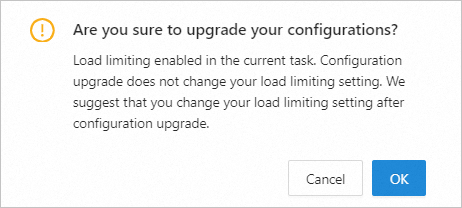This topic describes the specifications and performance of the data transmission service provided by ApsaraDB for OceanBase, and shows how to upgrade the instance specifications for a data migration or synchronization task.
Considerations
The specifications provided in this topic are based on test data and for your reference only, but do not constitute criteria for evaluating the service level agreement (SLA) of the data transmission service.
The records per second (RPS) performance of incremental synchronization and the recommended maximum number of table objects to migrate or synchronize vary based on the instance specification. The data transmission service allows you to synchronize data to the destination with a seconds-level latency. However, a second-level latency cannot be absolutely ensured because the latency of a migration or synchronization task is affected by a series of factors, including the running load of the source instance, bandwidth of the transmission network, network latency, and write performance of the destination instance.
Terms
Specification: The data transmission service provides specifications with different performance measured by the number of synchronized records.
RPS: the number of incremental data rows synchronized to the destination table per second. For example, if 5,000 incremental data rows in the source database are synchronized to the destination table per second, the RPS value is 5,000.
Table object: the unit for data migration and synchronization. The recommended maximum number of table objects to migrate or synchronize is calculated by assuming that each table object contains a maximum of 50 fields.
Specifications
The data transmission service provides five specifications based on the migration or synchronization performance ceiling: MICRO, SMALL, MEDIUM, LARGE, and XLARGE. The performance ceiling for incremental synchronization can be reached only when the following conditions are met:
The load of the source instance is greater than or equal to the performance ceiling of the corresponding specification.
The destination instance is not bottlenecked by the write performance and can handle the performance stress of different specifications.
The network latency between the source or destination instance and the data transmission service is less than or equal to 2 ms.
The number of table objects to migrate or synchronize is smaller than or equal to the recommended maximum value provided in the following table.
Specification
Maximum RPS (for reference only)
Recommended maximum number of table objects
MICRO
300
100
SMALL
3,000
2,000
MEDIUM
5,000
40,000
LARGE
10,000
100,000
XLARGE
25,000
200,000
NoteThe online performance is subject to various factors such as the network environment, the performance of the source and destination instances, and the network latency. Therefore, the actual performance values can vary slightly. The performance ceilings provided in the preceding table are for reference only and do not constitute any commitment of the SLA.
Upgrade the instance specifications
If the current instance specifications cannot meet the business needs, you can upgrade the instance specifications for your data migration or synchronization task.
Limitations
At present, you cannot downgrade the instance specifications for a data migration or synchronization task.
For a data migration task, you can upgrade the instance specifications only when the task is in the Running state and the incremental synchronization or reverse incremental migration step is being performed properly.
For a data synchronization task, you can upgrade the instance specifications only when the task is in the Running state and the incremental synchronization step is being performed properly.
For a data migration task in the Configuration changing state, you cannot start the forward switchover step, or add or remove migration objects.
For a data synchronization task in the Configuration changing state, you cannot add or remove synchronization objects.
When you migrate data from a PolarDB-X 1.0 database to a MySQL tenant of OceanBase Database, if your instance is associated with multiple tasks, you can upgrade the instance specifications only when all of the associated tasks are in normal progress of incremental synchronization or reverse incremental migration.
Procedure
Log on to the ApsaraDB for OceanBase console.
In the left-side navigation pane, choose Data Transmission > Data Migration.
This procedure shows how to upgrade the instance specifications for a data migration task. To perform the upgrade, choose Data Transmission > Data Synchronization and perform related operations on the Synchronization Tasks page.
On the Migration Tasks page, click the More icon next to the target task and select Upgrade.
You can also click the name of the task to go to its details page. Then, click the More icon in the upper-right corner and select Upgrade.

(Optional) In the dialog box that appears, click OK.
If you have enabled the throttling feature in the incremental synchronization or reverse incremental migration step of a data migration task, or in the incremental synchronization step of a data synchronization task, you must click OK in the dialog box that appears. If you have not enabled the throttling feature, you can skip this step and directly go to the Upgrade Specifications page.

On the Upgrade Specifications page, select the required instance specifications and then select I have read and agree Data Transmission - Pay-as-you-go Terms of Service.

Click Buy Now.
After the purchase, you can return to the Migration Tasks or Synchronization Tasks page to view the instance specifications for the current task.
